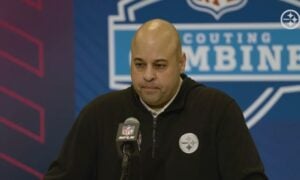While writing about new punter Brad Wing’s chances of becoming the regular punter for the Pittsburgh Steelers, and the comments regarding him made by team general manager Kevin Colbert at the NFL Combine, I also touched on the topic of underclassmen and maturity levels, and I think it’s worth further comment.
With the news that a record number of underclassmen have declared for the 2014 NFL Draft, it makes me wonder how many more players there will be like Brad Wing. Colbert described this class as one of the most talented that he’s ever seen, but also has the potential to be the most immature, with a high level of ‘bust-ability’, thanks to the near-triple-digit influx of underclassmen involved.
I find this quite interesting, because it could change the dynamics about how this whole system works, both on the college and professional levels.
One of the more unusual implications that a rise in underclassmen declaring for the draft could potentially produce is a cyclical depletion of NFL-quality talent from the college ranks from the following draft.
It’s a fairly straightforward idea; the underclassmen of one draft would be the premium talents that would have been the top of their senior classes declaring for the draft the following year. As a result, this current draft, for example, contains an unusually high proportion of elite both senior and underclassman talent.
This is what has led Colbert and others to speculate that this could be the most talented draft class in a generation or more by combining the vast majority of the best from the senior class and the cream of the crop of the next class behind them, most notably with players such as Jadeveon Clowney and Johnny Manziel.
As a byproduct of this, some of the best players that would normally be coming out next year will be gone, and that could very well correlate to a weaker draft class in 2015, for example, such as that of the 2009 draft with a notoriously ‘bustable’ first round.
As always, of course, there will be players who finally jump into the limelight during their senior seasons that one cannot anticipate based on the earlier tape, whether due to increased playing time or health and other concerns.
Depending on the viability of underclassman athletes—of which this class with its nearly triple-digit uncerclassmen could serve as a litmus test—we could see, over time, the focus of the draft shift away from senior college players and toward the junior players, simply because the senior class will have been depleted.
For a while, it may still be the case that the bulk of the draft, especially the upper echelon, is made up of players who have used up their eligibility, which could result in the aforementioned cycles of draft quality based on how strong the underclassman presence in a particular draft might be.
Because athletes are only becoming increasingly more prepared for a professional career at a younger and younger age, however, it may be the case that it will be the norm for players to declare for the draft early, and that senior players will be in the minority.
After all, there is increasingly less incentive for athletes to stay in college, at least for career athletics purposes, and on the other side of the coin, NFL teams would rather get players younger if possible if the younger players of today are of the same maturity physically and mentally as the senior classes of tradition.
It’s no secret that the athletes of today have evolved and are continuing to evolve from years past. Just compare the overall size and athleticism of today’s athletes to what was commonplace in the 70s in the NFL, or even the 90s.
The next step of the evolution of the college athlete is not going to be from a physical perspective, however, but rather from the mental. As the league becomes more and more business-like, so too must players, and those who are more adept at understanding the business, both personal and professional, will only improve their draft stock.







